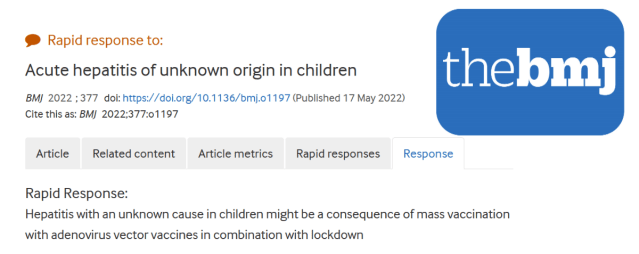Virologist tells BMJ the Hepatitis of Unknown Cause killing Children is due to AstraZeneca Viral Vector COVID Vaccine in combination with Lockdowns
A respected virologist/immunologist has writtent to the British Medical Journal to explain that the hepatitis of unknown origin that is both killing and causing children to have urgent liver transplants, is occurring due to the AztraZeneca Covid-19 Vaccine that was administered to millions in the UK.

A mysterious, deadly hepatitis of unknown origin is now affecting children all around the world. Public Health authorities have ruled out the common viruses that usually cause the condition, and dozens of children have required urgent liver transplants, whilst several others have sadly died.
The question on everyone’s lips though is ‘what on earth is causing this deadly outbreak of liver inflammation among children?’
A respected virologist/immunologist named Dr Ann-Cathrin Engwall has written to the British Medical Journal to explain what the mysterious cause could actually be. Her letter is printed in full below…
‘Dear Editor
Adenovirus infections might cause the acute hepatitis in children observed. It is present in 70% of the affected children in comparison to SARS-CoV-2 present in only 15% [1].
Furthermore, SARS-CoV-2 has spread worldwide for more than two years without cases appearing earlier. Adenovirus infections do not normally cause hepatitis in healthy children suggesting that a completely new type of adenovirus might have been introduced into the human population.
The question one must ask in this case is what factors and events have occurred recently that distinguish the UK from other countries since it seems to be the origin and where most children have been affected by hepatitis with an unknown cause.
A substantial proportion of the population in the UK has received Vaxzevria which is an adenovirus vector vaccine from AstraZeneca developed by the Jenner Institute in Oxford [2].
The chimpanzee viral vector was selected due to the low herd immunity in the human population and originates from an adenovirus purified from the faeces of chimpanzee cubs [3].
The vector is genetically modified so that it cannot multiply, and genes of interest can be added. In Vaxzervria, the DNA sequence expressing the spike protein from the original Wuhan SARS-CoV-2 virus has been inserted [4].
Could the adenovirus vector vaccine have contributed to a new recombinant virus? Even if the virus vector does not multiply there is an obvious risk exposing such a large number of individuals that recombination with an adenovirus could occur.
Multiplicity reactivation (MR) is a survival mechanism that was discovered for adenoviruses in 1971 by Yamamoto and Shimojo [5]. It is a process where damaged adenovirus genomes can interact with other adenoviruses present in the cell forming a new viable viral genome.
The mechanism is described as an early variant of a reproductive (sexual) process that can occur in microorganisms [6]. A proportion of the population, especially individuals with a compromised immune system, is carrying latent adenoviruses.
In Sweden, approximately 20% of adults and 50% of kindergarten children are carriers. This safety issue of viral-vector delivery systems was often discussed in the beginning of the development of these medical tools.
It is the first time in history that so many individuals have been exposed to adenovirus vector vaccines. The risk for recombination’s with adenoviruses is therefore increased.
Lockdown, closing the society aiming to stop the spread of coronavirus, recently also occurred in the UK. The susceptibility for all kind of infections will, unfortunately, increase afterwards due to less herd immunity, particularly in young children.
They are relatively unexposed to different viruses and need to build up immunity against different pathogens. A new adenovirus therefore can spread more quickly after isolation measures because there is an immunity debt in the population.
The virus load can become high in susceptible individuals causing more severe infections and damage to the gastrointestinal area that might lead to viral hepatitis.
If adenovirus infections are causing acute hepatitis in children, the severe cases could just be the tip of the iceberg and the majority infected by the adenovirus would have less severe symptoms. The virus may have spread to other countries from the UK, but it is also possible that adenovirus recombinations may have occurred independently elsewhere in the world where adenovirus vector vaccines also have been used.
Development of a new more pathogenic adenovirus could be caused by using adenovirus vector vaccines in large populations, and it is consistent with the facts available. To investigate this important safety issue of viral vector vaccines, sequencing of entire adenovirus genomes from cases and comparisons with the vaccine viral vector is necessary to verify or dismiss this hypothesis.
REFERENCES
1. https://www.gov.uk/government/news/increase-in-hepatitis-liver-inflammat…
2. Folegatti, Pedro M et al. “Safety and immunogenicity of the ChAdOx1 nCoV-19 vaccine against SARS-CoV-2: a preliminary report of a phase 1/2, single-blind, randomised controlled trial.” Lancet (London, England) vol. 396,10249 (2020): 467-478. doi:10.1016/S0140-6736(20)31604-4.
3. Morris, Susan J et al. “Simian adenoviruses as vaccine vectors.” Future virology vol. 11,9 (2016): 649-659. doi:10.2217/fvl-2016-0070
4. Zhu, Na et al. “A Novel Coronavirus from Patients with Pneumonia in China, 2019.” The New England journal of medicine vol. 382,8 (2020): 727-733. doi:10.1056/NEJMoa2001017
5. Yamamoto H, Shimojo H “Multiplicity reactivation of human adenovirus type 12 and simian virus 40 irradiated by ultraviolet light.” Virology. 45,2 (1971): 529–31. doi:10.1016/0042-6822(71): 90355-2. PMID 4328814.
6. Michod, Richard E et al. “Adaptive value of sex in microbial pathogens”, Infection, Genetics and Evolution, vol. 8,3 (2008): 267-285. ISSN 1567-1348, https://doi.org/10.1016/j.meegid.2008.01.002. (https://www.sciencedirect.com/science/article/pii/S156713480800004X)
Competing interests: No competing interests
Ann-Cathrin Engwall
PhD, immunology, virology
Uppsala, Sweden’
The original letter to the BMJ can be viewed here.



